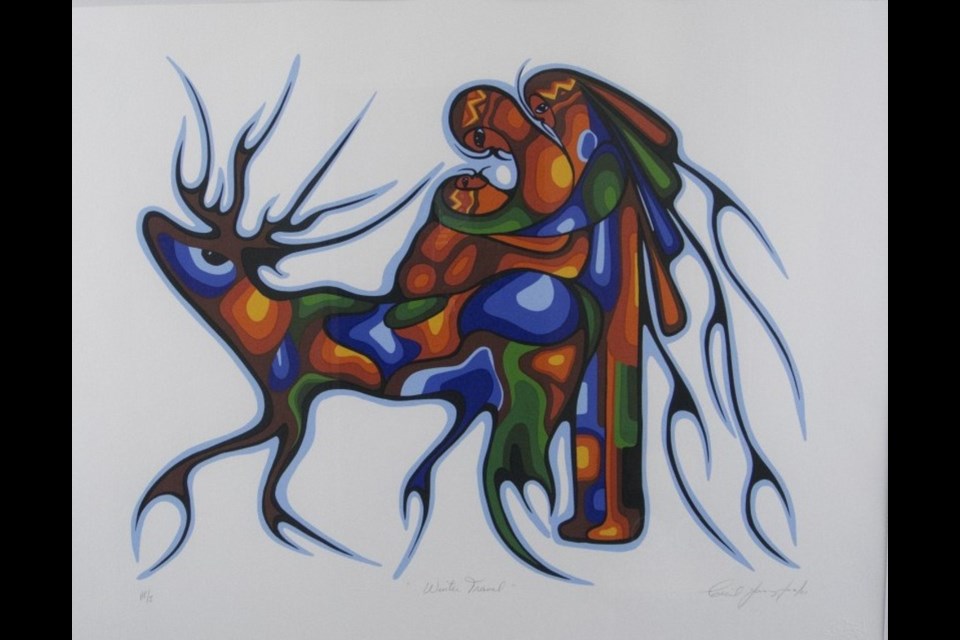Remember the time when Winter Travel came in the form of a postage stamp?
It is not often that the winter season is characterized as warm and inviting, but through the power of art, Cecil Youngfox provided our community with that energy through the spirit of his artwork. One such work, the aforementioned print entitled Winter Travel.
As part of a collection of stamps put out by Canada Post, Youngfox’s print was featured, as one of the three creations that showcased Indigenous artists’ artwork. Despite being entitled Winter Travel, there is something comforting and warm emanating from the canvas; in this case a stamp. Through the use of the warm colours red, orange and yellow, Youngfox was able to create an image of harmony between people and nature, and the close connection to family.
Cecil Youngfox, who was internationally known, once stated “I sincerely believe that whatever the work of art created, be it in song, story, stone sculpture, or painting, it ever must reflect a bit of that personal you, for perhaps unknowingly you have injected part of your life, your religion, beliefs, even your hopes and despairs into that finished product” (Sault Star, 03-28/1979, pg.20).
Staying true to this theme, in the late seventies, Cecil Young adopted the suffix ‘fox’ to his surname to better reflect his artwork, but more importantly honour his Métis heritage. When asked to describe his artwork, he stated “the people I paint are my family and friends and [Indigenous] values that surround them” (Sault Star, 02/25/1987).
The Métis artist’s artwork tells a story written on a canvas about a life that was “simple, yet full of profound meaning” (02/25/1987). It was at the Vancouver City College in 1974 where the Skin Point artist developed his ability to tell stories of his youth on a canvas. These ‘simple’ stories with ‘profound’ meaning earned Mr. Youngfox well-deserved recognition in November 1980 at the Native Council of Canada’s General Assembly.
Cecil Youngfox certainly injected aspects of his versatile background into his creations, having studied at a seminary school in Alberta, worked as a teacher in Ontario and a steelworker here in Sault Ste. Marie. However, his artwork’s ‘bit of personal you’ that is apparent is the warmth of character in which he had, being described as “a very gentle, approachable man with an extraordinary gift to create beauty in his art” (Sault Star, 02/28/1987).
At the age of forty-four, Cecil Youngfox succumbed to cancer in Toronto. To the beat of the sacred drum, mourners expressed their sorrow and respect to the acclaimed artist with offerings of “braided sweetgrass, a rose, a feather and a cross” (Sault Star, 02/28/1987). As likened to his artwork, all of these offerings ‘reflect a bit of that personal’ him.
Sweetgrass being one of the four sacred medicines, “used for purification and represents kindness”, and a “feather represent strength and courage…to acquire a feather, people need to work hard for them” (Kinoomaadiewinan Anishinaabe Bimaadizinwin, Book 1, 21-22). Youngfox was not only a talented artist but should be recognized for the quality of his character as well. It was through his artwork however that his spirit lives on, and honours his heritage.
The paintings of Cecil Youngfox were left to the Municipality of Blind River, and throughout the community in various Municipal buildings, including the Blind River Public Library.
The Blind River Museum is set to pay tribute to Cecil Youngfox this fall, as it marks, what would have been his 80th birthday. If you want to view the local artist’s work, the exhibit will take place this fall at the Timber Village Museum Art Gallery.
Each week, the Sault Ste. Marie Public Library and its Archives provides SooToday readers with a glimpse of the city’s past.
Find out more of what the Public Library has to offer at www.ssmpl.ca and look for more Remember This? columns here.
